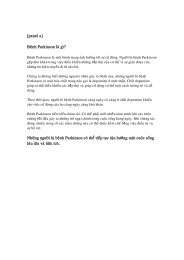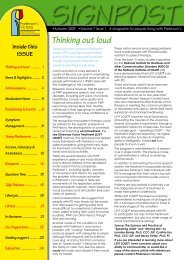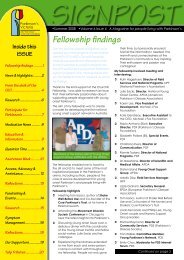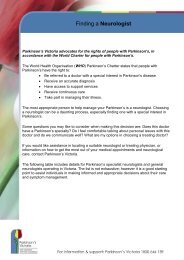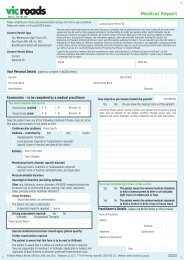RWT Report Final- 20.11.08 - Parkinson's Victoria
RWT Report Final- 20.11.08 - Parkinson's Victoria
RWT Report Final- 20.11.08 - Parkinson's Victoria
You also want an ePaper? Increase the reach of your titles
YUMPU automatically turns print PDFs into web optimized ePapers that Google loves.
Respite without the tears<strong>Final</strong> <strong>Report</strong>ContentsBackground 3Current experience of respite 5Possible solutions named by carers 9Discussion 12Recommendations 132
Respite without the tears<strong>Final</strong> <strong>Report</strong>Respite without the Tears – <strong>Final</strong> <strong>Report</strong>BackgroundParkinson’s is a progressive, degenerative, neurological condition which involvesa disturbance in the coordination of movement. No two people with Parkinson’sare the same, or will experience a similar journey in terms of symptomprogression or experiences.Up to 80,000 people in Australia are currently living with a diagnosis ofParkinson’s, with 25 people a day newly diagnosed, and an expected growth inthe prevalence by 15% in the next 5 years (Access Economics, 2007). Thereach of Parkinson’s is felt far beyond that of the person diagnosed, but has ahuge impact on the carer, family, community and service system. The conditionis life-long and there is no cure available.People living with Parkinson’s (PLWP) rely on medication to try and controlsymptoms, however, over time the medication becomes less predictable in itseffect, making people prone to motor fluctuations and episodes of freezing,where they are completely unable to move. People with Parkinson’s are relianton a strict regime of medication (which is sometimes up to hourly), physicaltherapy and support from carers. Parkinson’s is generally perceived as an olderperson’s condition, however it affects people across the life span.Access Economics (2007) described Parkinson’s as “the second most commonneurological condition in Australia [which] remains one of the least understood interms of its cause. There is a lack of awareness in the health and generalcommunity of the challenges and needs of those suffering from this complex anddisabling condition, as well as community stigma and constraints in the deliveryof health and social support services.”3
Respite without the tears<strong>Final</strong> <strong>Report</strong>The experience of support agencies, Parkinson’s <strong>Victoria</strong> and Carers <strong>Victoria</strong> hasbeen that carers of people with Parkinson’s have found it difficult to accesstimely, appropriate respite services for their loved one – to give them a breakfrom their caring role, with confidence that their loved ones needs would not beneglected. In particular, when respite had been accessed, the carers typicallyhave a negative experience which led to deterioration in the health of the carerecipient and reluctance for the carer to engage support in again. Fyffe (2007)supports this in her report, stating that carers of people with Parkinson’s “copeduntil they can’t” and that there was a very small uptake of support services anddifficulty accessing the system in general.Parkinson’s <strong>Victoria</strong> and Carers <strong>Victoria</strong> then decided that they would holdforums to discuss the concerns of carers in more depth. This report records theexperience of 26 carers of people with Parkinson’s (and ProgressiveSupranuclear Palsy) into their current experience of respite and possiblesolutions.The role of the carerStrong cultural values around family caring – such as ‘caring is just what you dofor a family member’ – tend to render the carer invisible. Health professionalsand service providers more often focus on the ‘patient’ or ‘client’, which meansthat the carer is not included in care planning or in discussions about their ownhealth and wellbeing.There is now a substantial body of research that underscores the detrimentalhealth impacts of providing care. More than 60 percent of carers experiencehealth problems as a result of the strains of providing care. Recent researchhas highlighted that depression is higher among carers than the generalpopulation and there are emerging indications that the stress levels of carers aremuch higher than the person with the diagnosed condition.4
Respite without the tears<strong>Final</strong> <strong>Report</strong>Successful respite outcomes are therefore critical to the maintenance of balancein the carer’s life. This has the double advantage of improving the quality of careto the person with Parkinson’s as well as ensuring quality of life for the carer.Current Experience of RespiteOf the carers who had used respite, their experience ranged from a sub acutestay in hospital, to in-home and residential stays to day programs like exercise ormen’s groups. Their experiences were described as follows:Positive ExperiencesThe positive experiences were generally created when there was a sense ofbelonging and communication between the care agency and family. One carerreported that the facility staff met with her beforehand to sit down and discuss thesituation and care needs, work through paperwork together, and answerquestions. This was also intricately meshed in with the physical requirements ofthe condition being adhered and responded to (for example, facilities gettingmedication to the person on time, or the person being able to self-medicate andhaving the appropriate equipment available for mobility).Consistency of staff also helped with relationship building, knowledge of theperson receiving care and ability to provide more effective support.In home respite worked particularly well when the person with Parkinson’s wasable to self medicate as Personal Care Attendants cannot administer medication,and district nurses are not able to guarantee being there on time.Respite was also positive when the agency worked on interaction betweenpeople in the same circumstances (like social groups), with a focus being onactivities that people would want to engage in.5
Respite without the tears<strong>Final</strong> <strong>Report</strong>“My husband really enjoys the opportunity to meet new people and tosocialise with others. He is a very intelligent man and likes to meet others with adiverse background.”A two week respite was reported by one carer as very beneficial as it gaveher husband the opportunity to ‘experience conversations with others outside thehome’ because he was becoming fearful of not being able to do this any longer.One carer talked about a cottage style facility that was very good. What made itstand out was that it was a home like environment, with a maximum of 3 peoplethere at a time. Each person receiving care had their own room and a greateropportunity for individual attention from staff.Carers also found that their experiences of respite were more positive when theyfollowed the recommendations about good facilities from other carers of PLWP.Having staff who were educated and understood the complexities of Parkinson’smade a huge difference towards making respite a positive experience.NegativesNegative experiences in respite mainly fell into three categories. The first, andmost voiced problem with respite, was around medication administration andexpertise of staff. Carers said that the medication needs of the PLWP were notmet, which caused extreme anxiety for the carer and in some cases, caused adeterioration in the health of the PLWP. This was generally coupled with a lowawareness and lack of insight among care staff about the needs of PLWP.“My husband (or nursing staff) would call everyday to report problems, so Inever felt like I ever had a chance to escape my responsibilities.”6
Respite without the tears<strong>Final</strong> <strong>Report</strong>“I had to remember to call to remind the nursing home about medication.There was a lack of responsibility by staff for timely medication administration.”“Meds were still not given 2 hours after they were due. I had to get a staffmember from MDP Kingston to call the facility to talk to them about care needs.Kingston was very helpful but it didn’t help the care from the facility however.”There was also a problem with continuity of staff in both residential and in-homerespite.The second category of issues involved problems with access to respite,navigating the system, and respite not being appropriate to meet the needs ofpeople with Parkinson’s. Carers found the process of dealing with manygovernment departments intimidating and confusing.Also, services available were dependent on locality, which gave the impressionof a “Post code lottery”, so those living close to Caulfield, for example, were ableto access sub-acute stays, whilst those in the Western region had lessspecialised services available.“I had had an operation and needed respite for my husband while I recovered.ACAS were not flexible enough to fulfil this need and I was left to strugglethrough my recovery as well as care for my husband.”In particular carers felt that some types of respite available did not allow themany freedom, as by the time they had dropped the PLWP off at the respite facility,it was time to come back again after only having done a couple of chores athome.Carers were also concerned about the quality of respite as there was a verylimited range of activities available, in most cases with minimal opportunities for7
Respite without the tears<strong>Final</strong> <strong>Report</strong>meaningful engagement with other people. Carers sometimes felt that they werepunishing their partner in respite as they were confined to a chair andencouraged not to move around. One carer described the person receiving carebecoming extremely isolated during the stay as there were no opportunities toengage with others.Problems with the cost and issues with Centrelink were of particular concern.Centrelink was not considerate of the issues faced by carers in their role and isforcing some of them to take on work somewhere in between the immense carerduties. The Welfare to Work changes in particular were very frightening forcarers – as the nature of Parkinson’s means that thing will worsen over time andthe carer burden will increase.The third category of issues that contributed to a negative experience in respitewas the behaviour of the person receiving care upon return home. Some carersfelt that they were being punished by the person they were caring for after therespite as they didn’t want to go in the first instance. One carer describeddifficulty in the person receiving care adjusting on their return home. Herhusband would return very angry and take it out on her.One carer described an incident where her husband had a period of a week inhome respite while she went overseas and visited relatives. Upon her return, herhusband had become totally withdrawn, refusing to open curtains, or turn on thetelevision.One carer described continuity of Home Care Workers as an issue. She saidthat once she had Home Care Worker trained up in her mother’s routine (ie.creaming the legs etc), the workers had swapped and she had to start again.Working through a case manager who was not present at point of care was alsofrustrating.8
Respite without the tears<strong>Final</strong> <strong>Report</strong>These negative issues made carers feel insecure and anxious about accessingrespite. It also led to a reduced uptake of respite services with consequences forthe wellbeing of carers of people living with Parkinsons.What carers want- Respite that fits in with lifestyle- Sleep- A break form the relentless nature of caring- Someone to help them with all of the negotiation.- Freedom- Welfare Benefits and help with finances.Some possible solutions identified by carersMedication / Staffing:- Having Parkinson’s Trained Staff at the respite facility- Medication administered by registered nurses only- Consistency of workers for in home respite.- Paid carers being able to prompt the client for medication.- More open communication channels between family carers and the paidcarers – such as implementing diaries that can be used to improvecommunication between carers.- Being able to negotiate with staff regarding the administration ofmedication (which gives freedom to enjoy the respite)- Staff taking responsibility for any treatment needs that may arise – whilenotifying may be important, there should be no expectation of the carerhaving to take any action (ie. “Don’t call me if J’s urine has blood in it –you deal with it”).- Increased staffing levels at the facility, particularly an increase in qualifiednursing staff.9
Respite without the tears<strong>Final</strong> <strong>Report</strong>What will improve the respite experience:- Including the PLWP and carer in the process and having a planned, easyto understand approach about how respite is delivered, --- Offer alternatives to the current service delivery – have the system fit theperson and not vice-versa.- Having a holistic approach to care – like a ‘centre for excellence’, whereone knows the people, is able to get all the services one needs and havea variety of different respite models which are all Parkinson’s specific (ie.Social support programs, in home respite, facility based respite,physiotherapy).- 'Provide respite in ‘day blocks’ so that one can achieve something that onewants to do in that time – not little two hr blocks;- ‘by the time you get out,you need to get back home again’.- Make respite fun – and something that one would want to do! Like abowls group – where all the people have Parkinson’s and no one is goingto judge one or make one feel bad about being slow.- Simplify paperwork- Respite having more mentally stimulating activities rather than it being aplace where one has to sit down all day.- Including transport costs in the funding. Often the cost for attendance isprohibitive.. Transport also needs to be disability friendly.- Booking slips to ‘bank’ respite and use when needed.- Respite should be accessible regardless of where one lives and oneshould not be disadvantaged for living in the West.- Having an advocate and someone to help with negotiating the systemwould be very useful.- A system for recording recommendations from PLWP- Regularity – knowing one has a day a week or every two weeks makes ahuge difference - ‘gives me freedom’.10
Respite without the tears<strong>Final</strong> <strong>Report</strong>“People need to know about the services that are available in the communityto support PLWP and carers. Some people get told about certain optionswhilst others miss out – pot luck!”There is a need for better access to and understanding about aged carepackages available (eg. Linkages, EACH).Further scenariosThe following comments by carers reveal the varied experience in relation torespite:“I thought I had to use respite in order to get the foot in the door so that we wouldbe eligible for permanent care in the future.”One carer spoke about staff from the local service who would only come toprovide assistance with showering and nothing else – such as providing promptsor reminders about medication. The staff are provided through the case managerwho I is no present when problems occur.“I have to call my husband during respite to ensure he takes his medication.”“I was ‘forced’ to take weekend respite as a pre-requisite to permanent care. Myhusband was left in a chair the entire time, so I brought him home.”“When I take my husband to bowls (informal form of respite) there is a lack ofunderstanding of others about his limitations, and why it takes him longer toplay.”11
Respite without the tears<strong>Final</strong> <strong>Report</strong>Discussion“The starting point for an appropriate service response for this group [people withParkinson’s] is ensuring consistent administration of medication. This must betackled as part of designing options to solely family or individual-based supportarrangements, particularly for out of home living and respite.” (Fyffe 2007)Most carers named this issue as a key concern. If the medication regime is notproperly administered, the whole respite experience degenerates in quality forboth the person receiving care and the carer and compromises the health of theformer. The major impact of this failure falls on the carer. This is a widespreadconcern among carers of people with Parkinson’s and it indicates a serious lackof responsiveness among service providers and is major deterrent to the use ofrespite services.However, as this report indicates, this is not the only concern that carers haveabout using respite. Once a person is admitted to respite care, the responsibilityfor that person’s welfare rests with the facility. The purpose of the respite stay isto provide the carer with a rest from caring. If the carer’s respite is interrupted bycalls from the facility (or the person receiving care) in regard to the care of theirrelative, it negates the purpose of the respite and its benefits. It is important alsothat the experience of respite be congenial for the person receiving care – hencestimulating activities, which are age and gender appropriate, are needed. Whenrespite is not a happy or successful experience, it is the carer who bears thebrunt of the dissatisfaction of the person receiving care – thus negating thedesired respite outcomes.12
Respite without the tears<strong>Final</strong> <strong>Report</strong>RESPITE WITHOUT TEARS – REPORT RECOMMENDATIONSRECOMMENDED THAT –1. The findings of the Respite without Tears project be presented to keystakeholders, including the Residential Respite Network of the <strong>Victoria</strong>nCarer Services Network, Parkinson’s Australia and Carers Australianetworks, as appropriate.2. This initial phase be followed up with further discussions aimed atexploring areas for improvement and strategies to help resolve the currentdifficulties carers and people with Parkinson’s experience in regard torespite.3. A Best Practice model of respite care for people with Parkinson’s bedeveloped. The model could include the following elements:• Additional staff training to assist staff in addressing the specialneeds of people with Parkinson’s.• A 3-way communication model involving the respite provider, familyand case manager.• An Intake Policy involving family, respite facility and case managerdesigned to elicit accurate information about care needs, interestsand stimulation.• The development of ‘Medication Contracts’ or other appropriate toolto ensure a correct medication regime for the respite user.• An Accreditation system giving recognition to facilities that haveimplemented the model.4. The development of a Transition Support model involving support forcarers and the care recipient in the transition into respite and the transition13
Respite without the tears<strong>Final</strong> <strong>Report</strong>to home following respite. This would include support for carers inaddressing concerns about service as well as relationship issues asindicated in the project report.5. Parkinson’s <strong>Victoria</strong> and Carers <strong>Victoria</strong> develop an education module forcarers to assist them in addressing their concerns relating to achievingsuccessful respite.6. Parkinson’s <strong>Victoria</strong> and Carers <strong>Victoria</strong> continue to work on strategies toraise awareness of this issue among service providers and seekgovernment support for implementing these reports. In particular, bothorganisations would work to develop and provide resources to provide arespite liaison worker to work with key stakeholders to implement theabove recommendations is indicated.14






